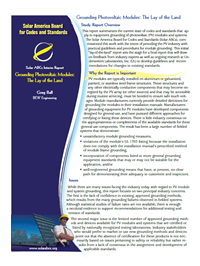
Grounding Photovoltaic Modules: The Lay of the Land
Download the one-page summary (PDF, 334KB) or the full report (PDF, 973KB).
Grounding Photovoltaic Modules: Issues and Recommendations
Download the one-page summary (PDF, 360KB) or the full report (PDF, 1.35MB).
Grounding Photovoltaic Modules: Addendum Report on Corrosion Testing
Download the one-page summary (PDF, 289KB) or the full report (PDF, 1.46MB).
Overview

The Solar America Board for Codes and Standards (Solar ABCs) commissioned this work with the intent of providing the photovoltaic (PV) industry with practical guidelines and procedures for module grounding. The objective of the overall grounding PV module study is to make recommendations for an integrated set of tests and procedures that can be incorporated into the standards governing the grounding of PV components.
The initial "lay-of-the-land" report provides an overview of the current state of codes and standards that apply to equipment grounding of PV modules and systems. The final report, "Grounding Photovoltaic Modules: Issues and Recommendations" draws on feedback from industry experts as well as ongoing research at Underwriters Laboratories, Inc. (UL) and presents the issues with recommendations for changes to existing standards. The addendum report provides updated information and recommendations related to corrosion testing of module grounding components and connections.
Why these Reports are Important
PV modules are typically installed on aluminum or galvanized, painted, or stainless steel frame structures. These structures and any other electrically conductive components that may become energized by the PV array (or other sources) and that may be accessible during routine servicing, must be bonded to ensure safe touch voltages. Module manufacturers currently provide detailed directions for grounding the modules in their installation manuals. Manufacturers of grounding equipment for PV modules have developed components designed for general use, and have pursued different approaches for certifying or listing these devices. There is little industry consensus on the appropriateness or completeness of the available standards for these general use components. The result has been a large number of fielded systems that demonstrate:
- unsatisfactory module grounding measures,
- violations of the module's UL 1703 listing because the installation does not comply with the installation manual's prescribed method of grounding the module frame,
- incorporation of components listed to more general grounding equipment standards that may or may not be completely suitable for the application, and/or
- well-engineered grounding means but no clear path for demonstrating their adequacy to customers and inspectors.
Issues
While there are many issues facing the industry today with regard to PV module and system grounding, these reports focus on two principal industry concerns. The first is the lack of confidence in existing, approved grounding methods, which results from the many grounding failures observed in fielded systems. Although statistical studies of failure rates are not available, there is enough anecdotal evidence to support recommendations for additional testing and revision of standards.
The second major issue is the limited number of approved grounding methods and devices available for PV modules and systems that are certified or listed by nationally recognized testing laboratories. Industry stakeholders who would prefer to market or use new grounding methods and devices point out that the absence of certification for these products is not necessarily based on issues pertaining to safety or reliability but rather results from a lack of consensus in the assignment and development of applicable standards.